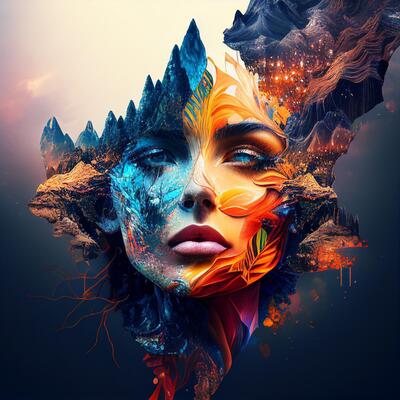Exploring the Diverse World of Artistic Expression: From Surrealism to Abstract Realism
In the world of artistic expression, from the dreamlike landscapes of surrealism to the detailed play of light and type in abstract realistic look, artists have actually continuously pressed the limits of creative thinking and creative imagination. Each movement holds an unique lens where the globe is seen and analyzed, providing a glance into the midsts of human emotion, assumption, and thought. As we discover the multifaceted world of art, we are offered with a tapestry of styles, methods, and approaches that test our understanding and prompt reflection. The journey with these varied types of artistic expression assures to unravel a rich tapestry of visual storytelling and intellectual inquiry that mesmerizes the mind and mixes the heart.
Surrealism: Letting Loose the Subconscious
Surrealism, a progressive imaginative activity of the 20th century, explored the midsts of the subconscious, introducing a world of dream-like images and unconventional associations. Spearheaded by musicians like Salvador Dali, René Magritte, and Joan Miró, Surrealism looked for to challenge the conventional means of seeing and recognizing art. With techniques such as automatism and desire analysis, Surrealist musicians aimed to use the unconscious mind to reveal surprise facts and needs.
Among the crucial elements of Surrealism was the focus on the unreasonable and the remarkable. By incorporating unforeseen aspects in their works, Surrealist artists intended to develop a feeling of disorientation and surprise in the audience. This disruption of reasoning and factor was indicated to provoke a deeper expedition of the subconscious and the secrets of the human psyche.
Abstract Realism: Redefining Understanding
Challenging conventional artistic boundaries, Abstract Realistic look redefines perception via the blend of identifiable elements with abstract kinds. This cutting-edge approach to art incorporates the representational precision of realistic look with the imaginative flexibility of abstraction, using viewers a distinct visual experience that motivates them to question their assumption of fact.
In Abstract Realism, musicians make every effort to catch the essence of their subjects while additionally infusing their job with a sense of deepness and complexity via abstract aspects. By blending the knowledgeable about the unfamiliar, these musicians invite target markets to engage with their items on multiple degrees, motivating them to explore the subtleties of color, kind, and texture.

Cubism: Breaking Up Fact
Utilizing geometric kinds and fragmented viewpoints, Cubism revolutionized the artistic representation of truth in the very early 20th century. This strategy not just deconstructed fact yet additionally emphasized the flatness of the canvas, paving the way for future abstract art movements.

Cubism can be categorized right into two primary stages: Analytical Cubism, defined by single color plans and complex, fragmented types; and Synthetic visit the website Cubism, which integrated collage aspects and brighter shades into the compositions. Through these distinct stages, Cubism affected not only paint however likewise sculpture, style, and layout. trump art. Its impact reverberated throughout the art globe, motivating artists to discover new ways of analyzing and standing for the world around them
Expressionism: Emotions on Canvas
Exploring the midsts of human emotions via expressive and vivid brushstrokes, Expressionism became an extensive creative movement in the very early 20th century. Unlike previous art movements that concentrated on portraying the exterior world, Expressionism explored the inner world of the artist's mind, intending to evoke raw feelings and prompt natural reactions from visitors.
Expressionist artists, such as Edvard Munch, Egon Schiele, and Emil Nolde, rejected standard notions of appeal and realistic look for misshaping form and color to share subjective feelings. The usage of exaggerated brushwork, strong shades, and distorted numbers aided create a feeling of worry, alienation, or passion in their jobs.
Among the most well-known examples of Expressionism is Munch's "The Scream," which catches the extreme anxiousness and anguish of modern life through its swirling, distorted figure versus a blood-red skies. Through their emotionally billed jobs, Expressionist artists sought to test conventional artistic norms and give a window into the unstable midsts of the human spirit.
Contemporary Art: Progressing Perspectives

One of the specifying qualities of contemporary art is its continuous advancement and ability to adapt to changing cultural landscapes. Artists are progressively including technology into their practice, blurring the lines between the electronic and physical worlds. This combination of tools permits cutting-edge ways of storytelling and engaging with audiences in a much more interactive way.
Additionally, modern art usually acts as a system for social commentary, attending to pushing problems such as identification, politics, and the atmosphere. Artists are using their work to spark important conversations and prompt thought, shedding light on the complexities of the globe we stay in. As viewpoints proceed to develop, contemporary art remains a vibrant and significant force in forming our social landscape.
Final Thought
In final thought, the world of imaginative expression incorporates a large range of activities and styles, each with its own unique strategy to sharing significance and emotion. From surrealism's expedition of the subconscious to abstract realistic look's redefining of perception, and from cubism's fragmentation of reality to expressionism's representation of emotions, art remains to progress and challenge viewpoints - trump art. Contemporary art mirrors the ever-changing world we live in, offering brand-new methods to interpret and recognize the complexities of our fact
As we check out the multifaceted globe of art, we are presented with a tapestry of styles, techniques, and ideologies that challenge our understanding and prompt consideration. Its influence reverberated throughout the art world, motivating artists to discover new means of standing for the globe and translating around them.
